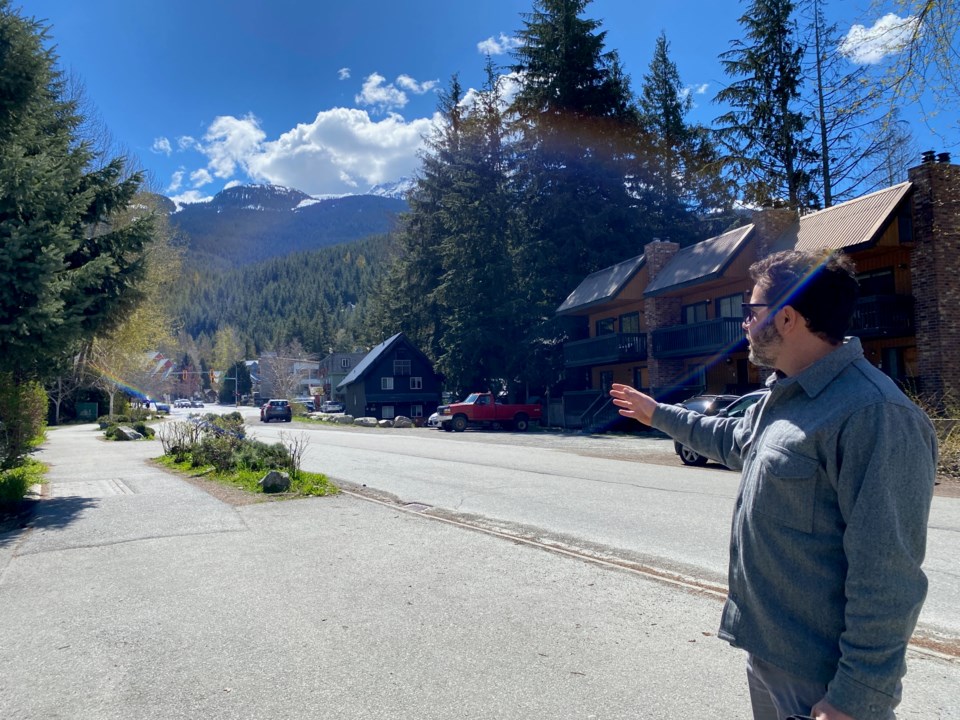Longtime locals with fond memories of the original Whistler—the area known today as Creekside—might have done a double take when they saw recently revealed concepts for the area.
A preliminary study of Lake Placid Road, produced in response to the B.C. government’s Bill 44, which will unilaterally allow the construction of three- and four-plex housing on single-family lots, was presented to Whistler’s committee of the whole on April 23, showing a drastic departure from what exists in the space today.
Multi-storey apartment buildings, a reimagined streetscape and pedestrian thoroughfare, completely redesigned facades and frontages, improved access to Nita Lake—this ain’t your grandaddy’s Creekside.
The ground-breaking is not imminent, but Bill 44 is, so it’s worth thinking about how its opportunities might be best captured, said the Resort Municipality of Whistler’s (RMOW) planning manager John Chapman over coffee in Creekside last week.
“That’s coming up very quick—by the end of June, we’ll have zoning in place that broadly looks at infill opportunities across all single-family residential zones for up to four dwelling units,” Chapman said. “And we wanted to make sure that we got this out now so that folks could see … [and] before they move forward with plans for triplexes or fourplexes, they might think about an opportunity to do more than that.”
Bill 44 sets minimum requirements municipalities have to respond to, but it also encourages them to go above and beyond if they can. Given the stretch of Lake Placid Road between Creekside and Nita Lake Lodge is identified in Whistler’s Official Community Plan as an area for study for further densification, staff saw an easy fit for a little visioning project.
As Chapman explained, the study is more about imagining how the space itself might be filled rather than what it will actually look like.
“[J]ust think about the volumes,” he said. “What does three or four storeys look like? How does that relate to the scale of this building, and Creekside Village? That’s really all we’re doing there.”
So if you saw the reimagined Southside Diner building in the mock-up image and wept for the Whistler that was, fear not—the actual urban design elements would require “significant community contribution, [and] lots more work with council and other key stakeholders,” Chapman said.
“We have to understand what Whistler is, and we have to make sure that everything that we do is reflective of the history and heritage of Whistler—that’s really important,” he added. “We also have to recognize that we have a need for more locals and workforce housing, and this is an opportunity to look at that, and to identify really key strategic locations.”
One of the most enticing aspects of the Creekside redesign study is the potential to reimagine the initial entrance to Whistler, both from an aesthetic and safety point of view.
“Imagine if you were driving north and you approached Creekside—how can we imagine it so that you really feel like you’re getting here? I think that should be a really big part of this work,” Chapman said.
“The views of the peak are amazing from here. Creekside Village, Franz’s Trail, I think there’s a ton more opportunity there to just make that really more of a place.”
Another key component of the study is improving public access to Nita Lake, Chapman added.
“If you imagine Lake Placid Road as a corridor, we want to make sure that a principle of the study is around improving that public realm, that idea of making it a really attractive place to move east and west for pedestrians,” he said.
The opportunities—and opportunities for angst—presented by Bill 44 are many, but the jury is still out on how effective, or transformative, it will be in Whistler. At least at first.
By presenting the Creekside concepts now, staff aim to paint the bigger picture of what might be in Creekside and beyond—eventually.
“Things take time, and we need to do it sensitively,” Chapman said, noting the RMOW planning team has a long to-do list, and redeveloping Creekside is not at the top.
“It’s an opportunity to have a conversation with the community.”
Considering the implications and transformative potential of Bill 44 reminds me, again, of one of my all-time favourite interview quotes, from a Whistler homeowner concerned about a neighbouring development: “The possibility that our lives may change scares me.”
Deeply profound, while somehow still saying nothing of substance; a futile expression of stubborn defiance in the face of unstoppable, universal forces. I just love it so much.
Change is not only a possibility, but an inevitability, and on a long enough timeline, it comes for everyone and everything.
We don’t have to like it, but it does us no good to be afraid.
The best we can really hope for is a chance to prepare.




